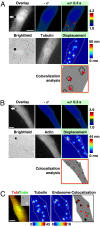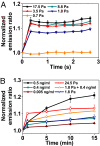Rapid signal transduction in living cells is a unique feature of mechanotransduction
- PMID: 18456839
- PMCID: PMC2373315
- DOI: 10.1073/pnas.0711704105
Rapid signal transduction in living cells is a unique feature of mechanotransduction
Abstract
It is widely postulated that mechanotransduction is initiated at the local force-membrane interface by inducing local conformational changes of proteins, similar to soluble ligand-induced signal transduction. However, all published reports are limited in time scale to address this fundamental issue. Using a FRET-based cytosolic Src reporter in a living cell, we quantified changes of Src activities as a local stress via activated integrins was applied. The stress induced rapid (<0.3 s) activation of Src at remote cytoplasmic sites, which depends on the cytoskeletal prestress. In contrast, there was no Src activation within 12 s of soluble epidermal growth factor (EGF) stimulation. A 1.8-Pa stress over a focal adhesion activated Src to the same extent as 0.4 ng/ml EGF at long times (minutes), and the energy levels for mechanical stimulation and chemical stimulation were comparable. The effect of both stress and EGF was less than additive. Nanometer-scale cytoskeletal deformation analyses revealed that the strong activation sites of Src by stress colocalized with large deformation sites of microtubules, suggesting that microtubules are essential structures for transmitting stresses to activate cytoplasmic proteins. These results demonstrate that rapid signal transduction via the prestressed cytoskeleton is a unique feature of mechanotransduction.
Conflict of interest statement
The authors declare no conflict of interest.
Figures




References
-
- Discher DE, Janmey P, Wang YL. Tissue cells feel and respond to the stiffness of their substrate. Science. 2005;310:1139–1143. - PubMed
-
- Giannone G, Sheetz MP. Substrate rigidity and force define form through tyrosine phosphatase and kinase pathways. Trends Cell Biol. 2006;16:213–223. - PubMed
-
- Janmey PA, McCulloch CA. Cell mechanics: Integrating cell responses to mechanical stimuli. Annu Rev Biomed Eng. 2007;9:1–34. - PubMed
-
- Orr AW, Helmke BP, Blackman BR, Schwartz MA. Mechanisms of mechanotransduction. Dev Cell. 2006;10:11–20. - PubMed
-
- Ingber DE. Cellular mechanotransduction: Putting all the pieces together again. FASEB J. 2006;20:811–827. - PubMed
Publication types
MeSH terms
Substances
Grants and funding
LinkOut - more resources
Full Text Sources
Other Literature Sources
Molecular Biology Databases
Miscellaneous

